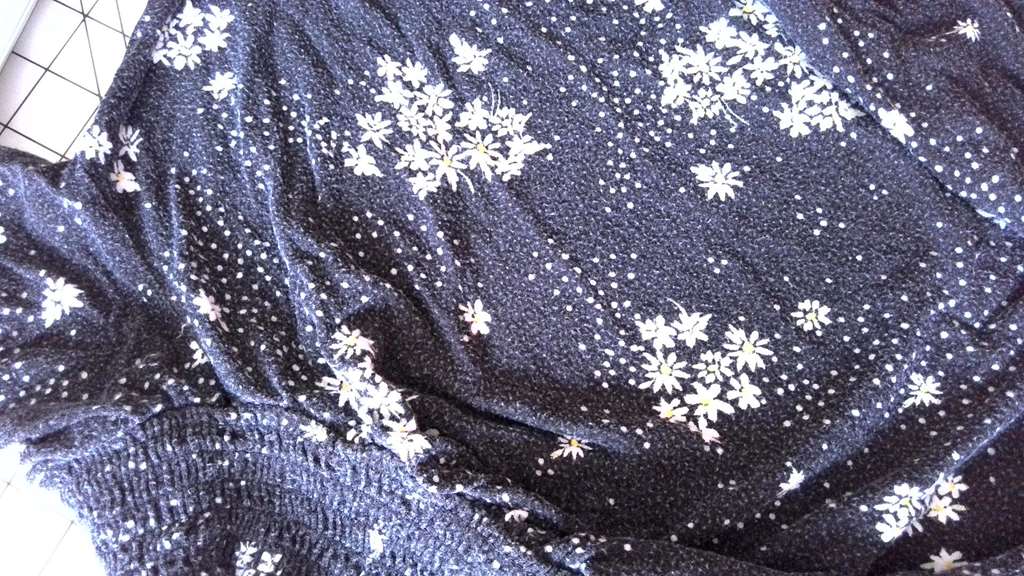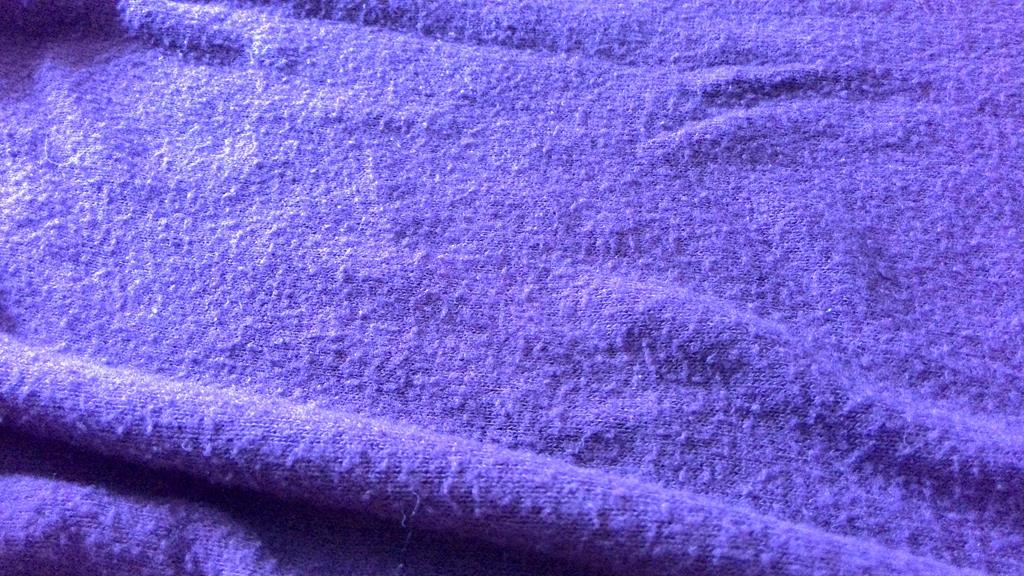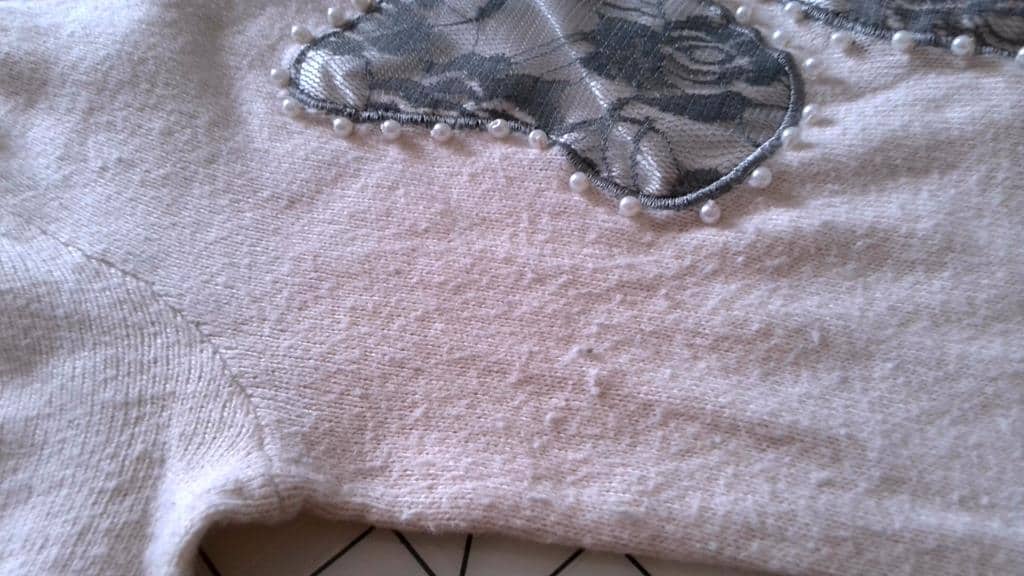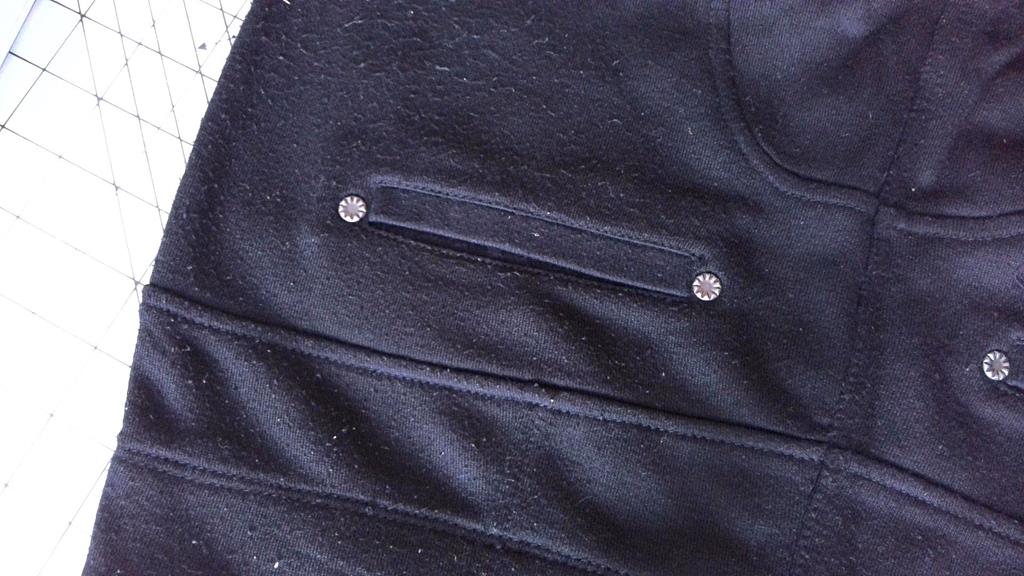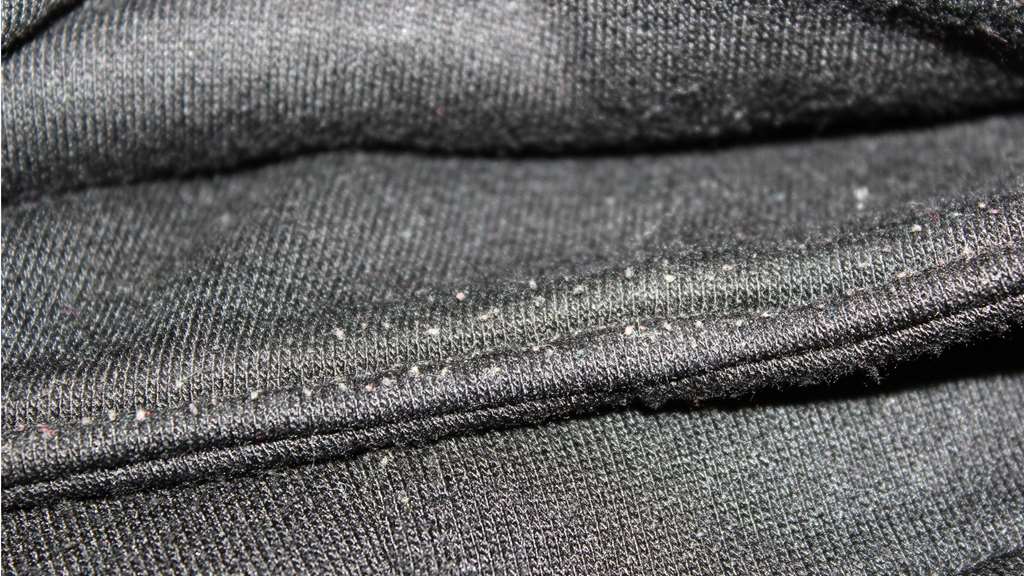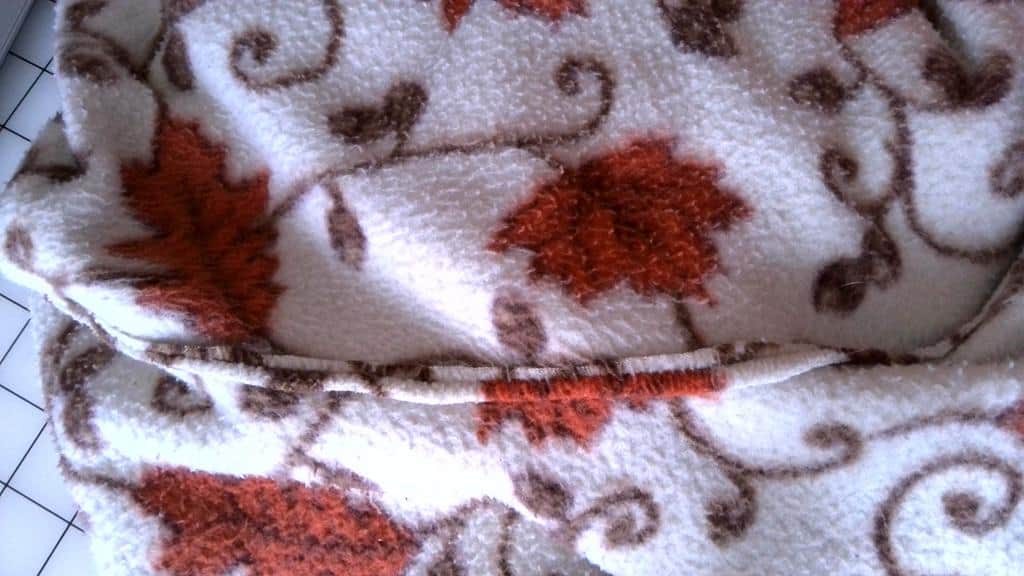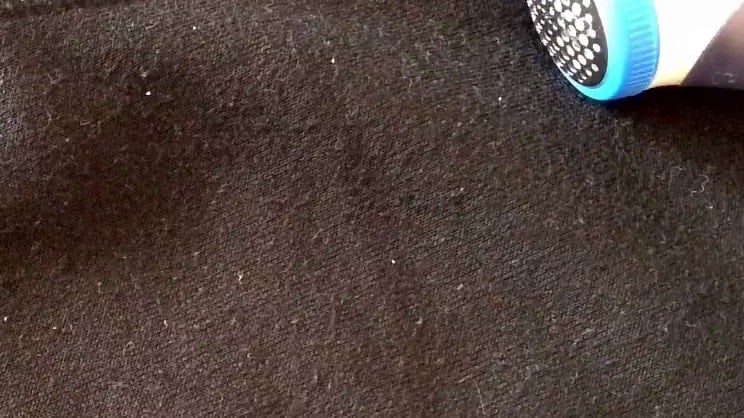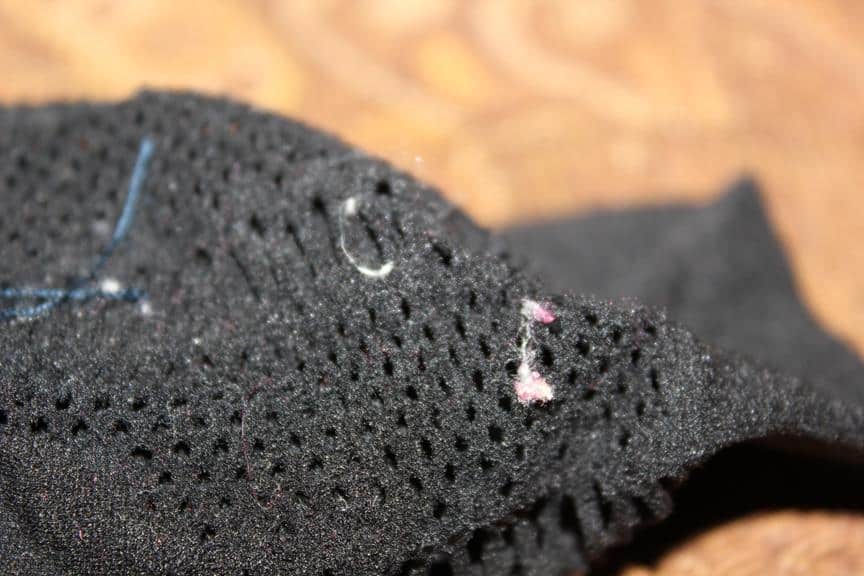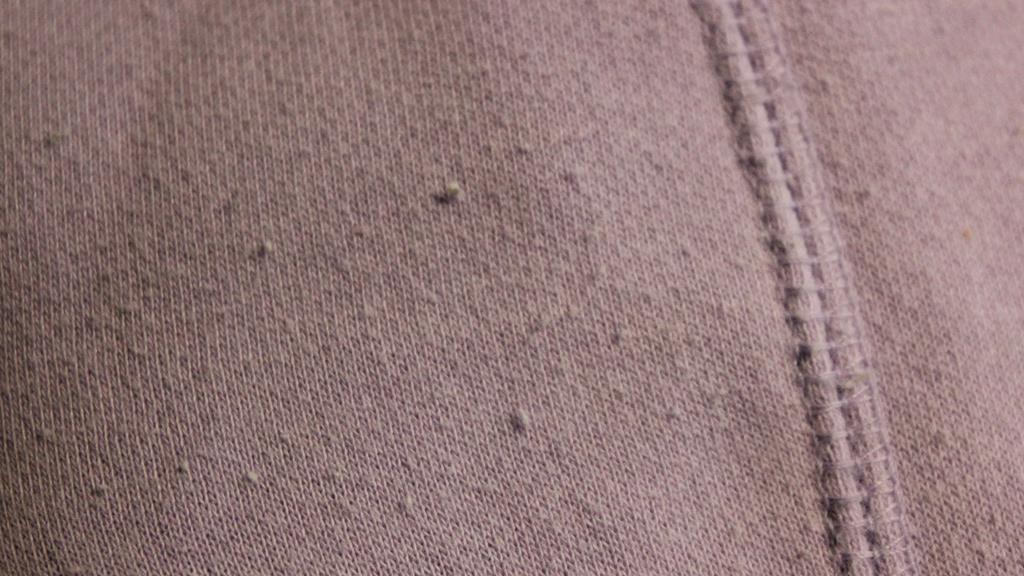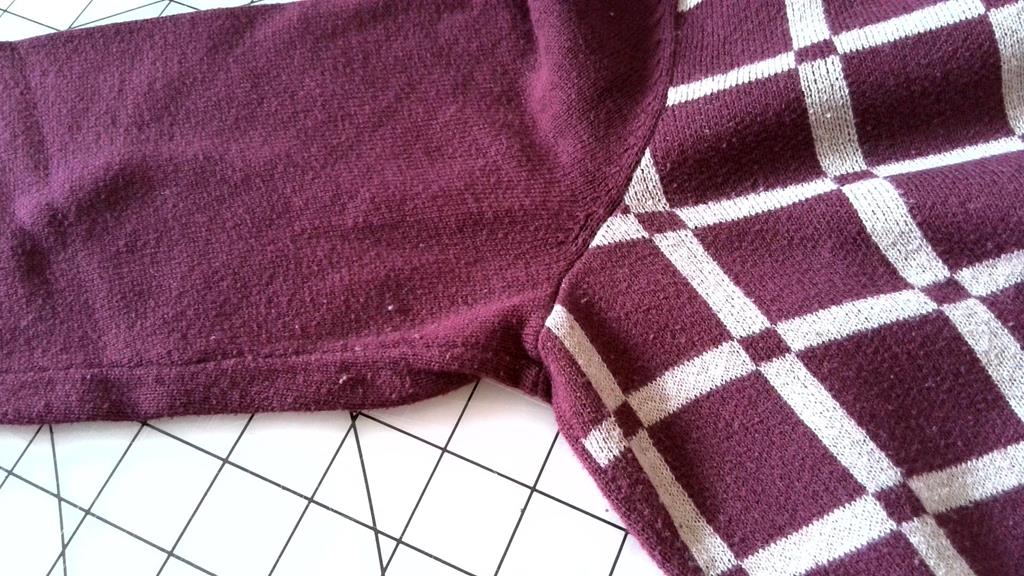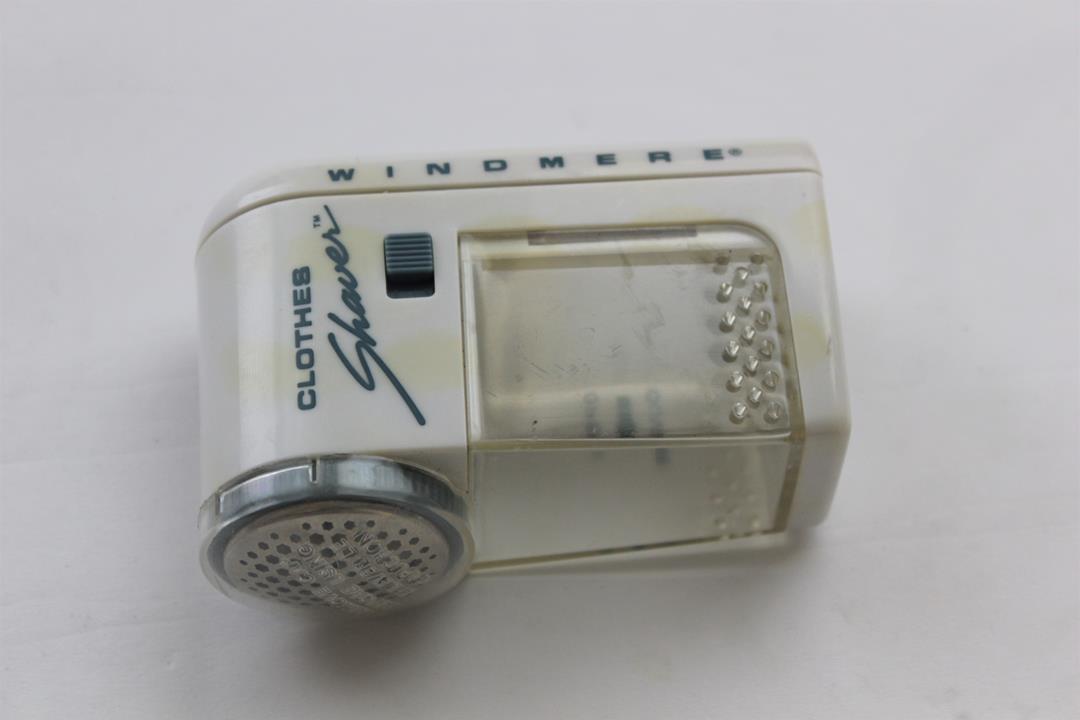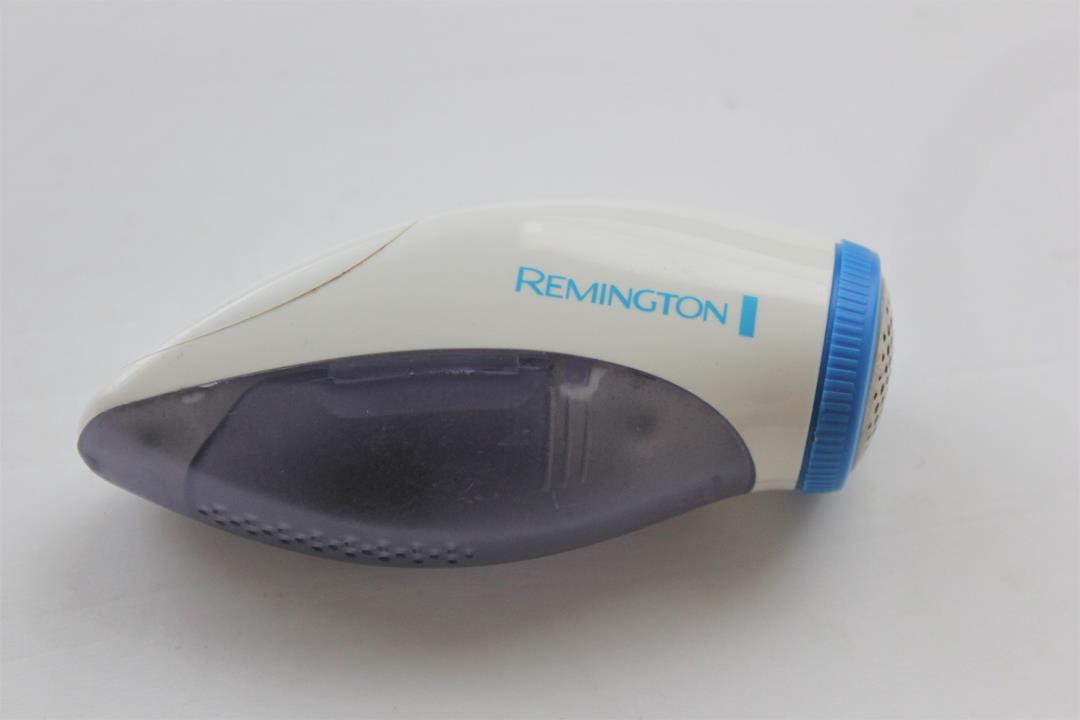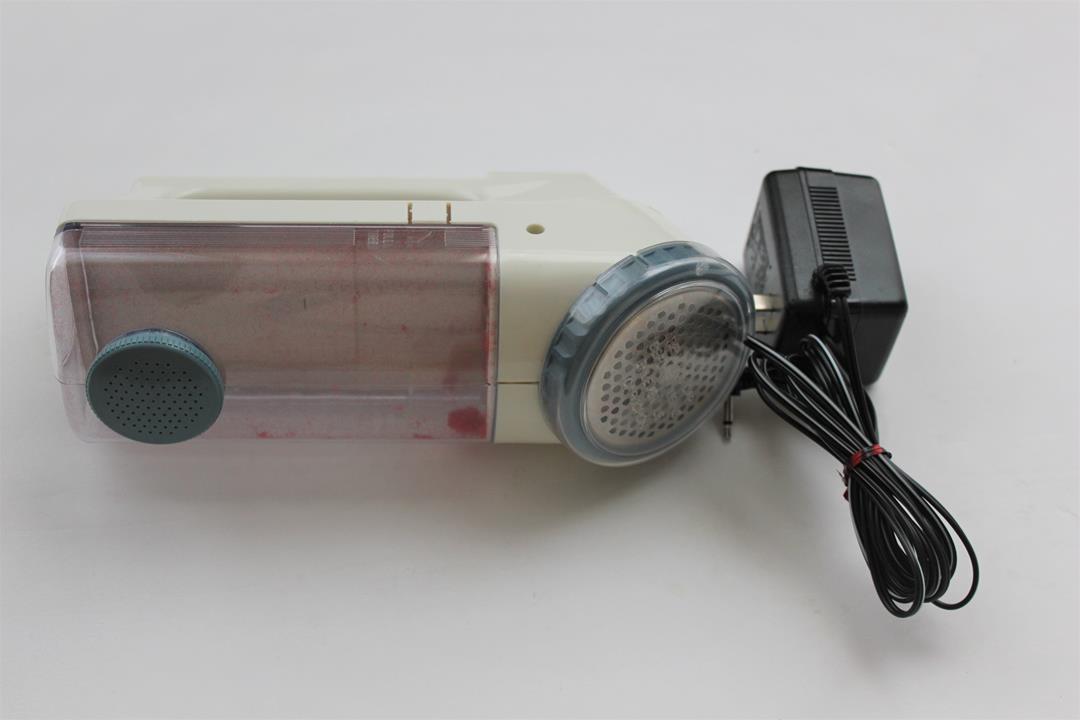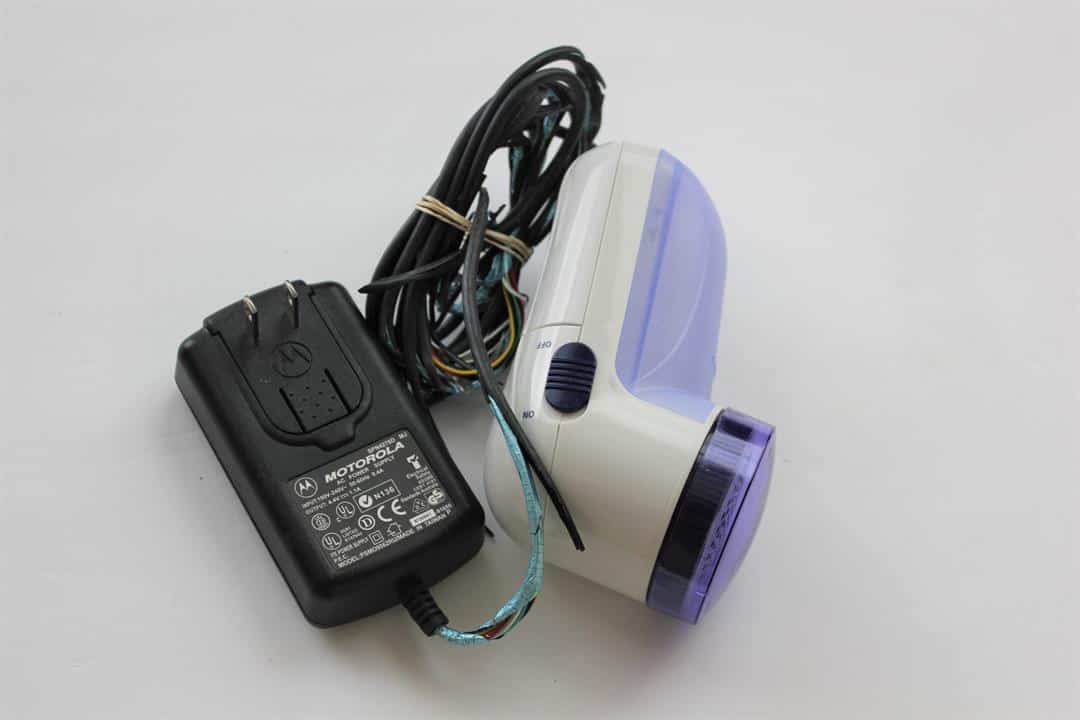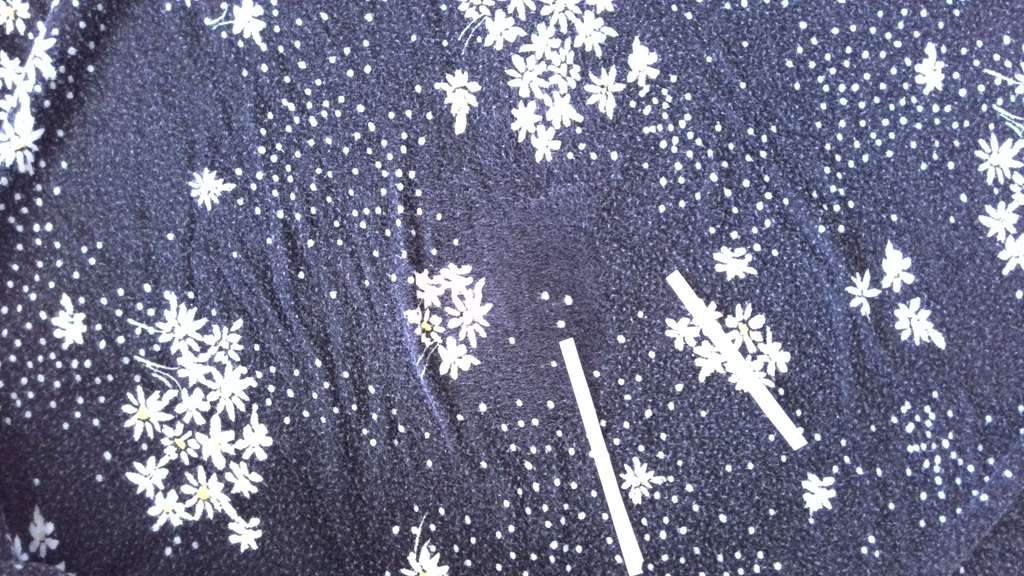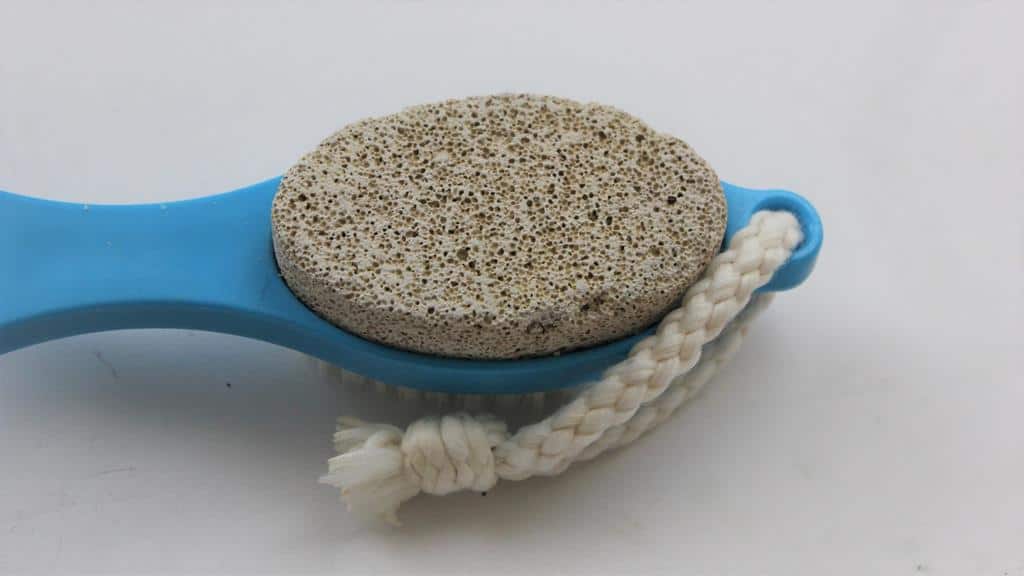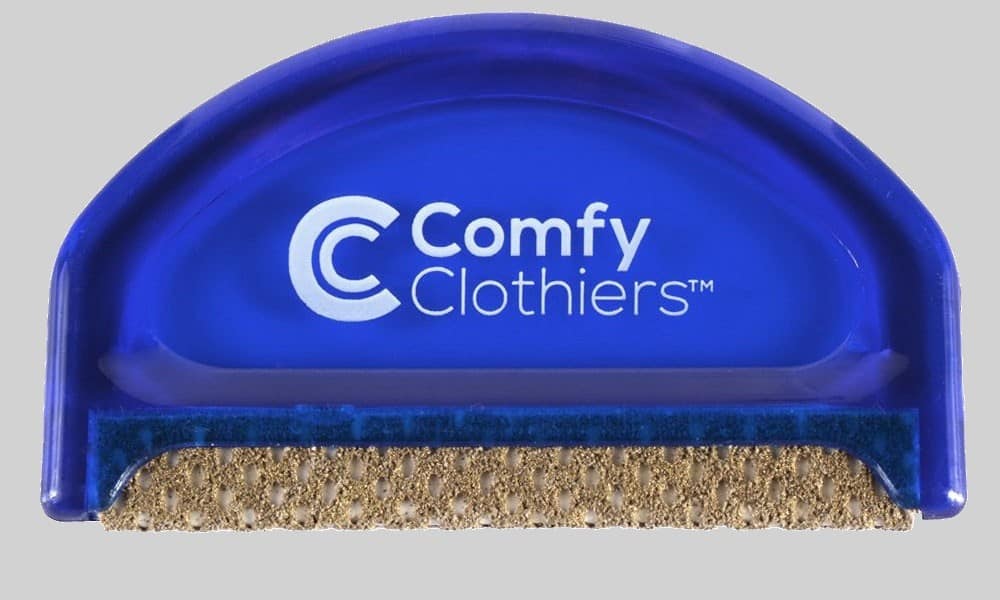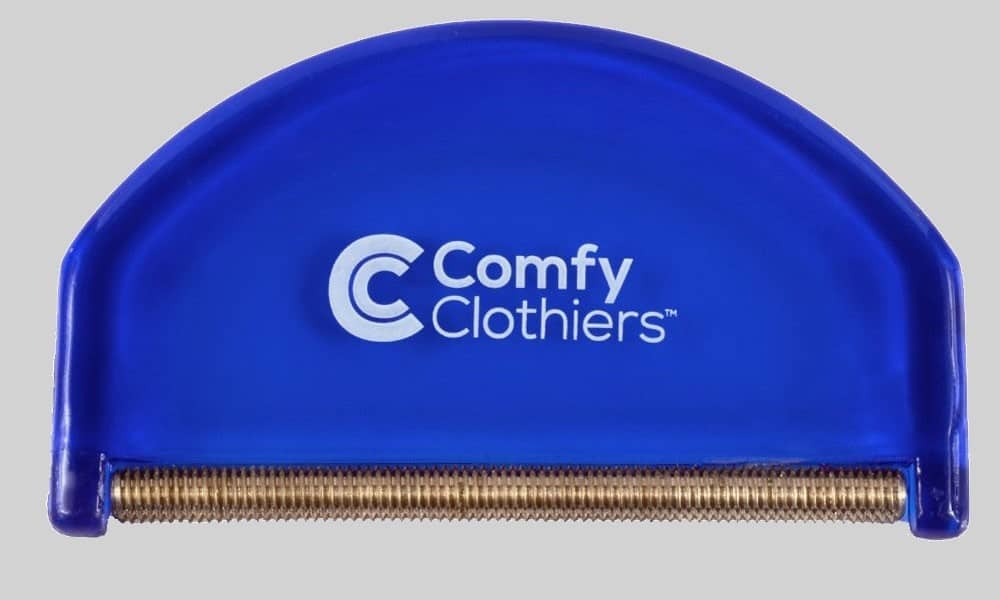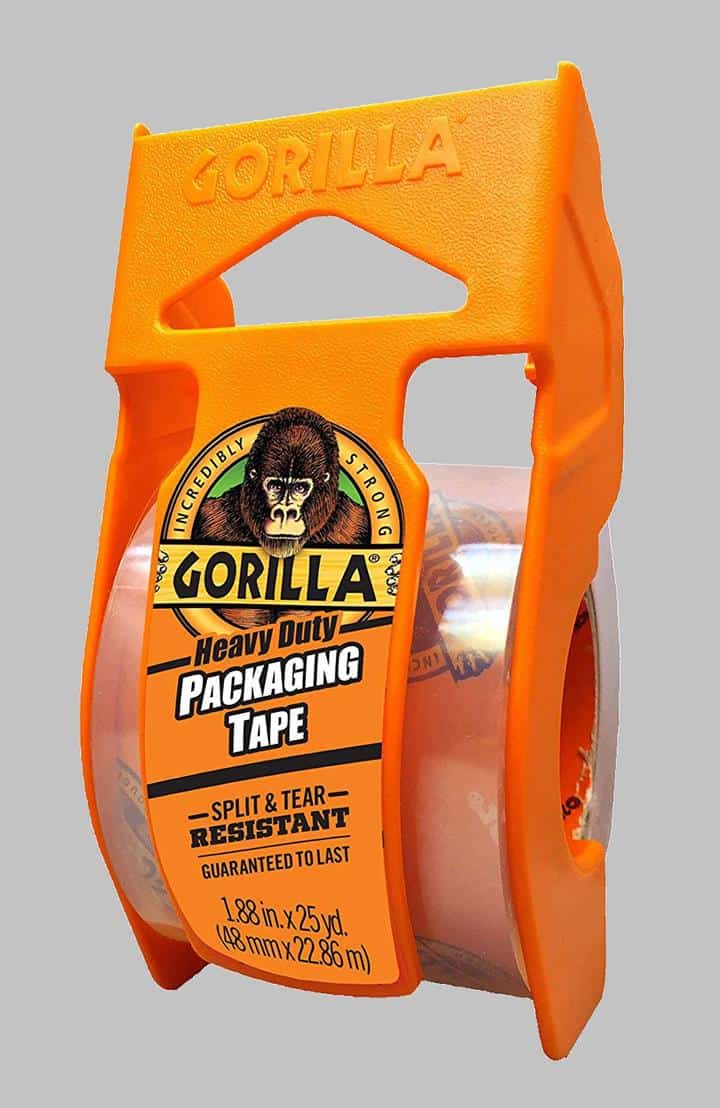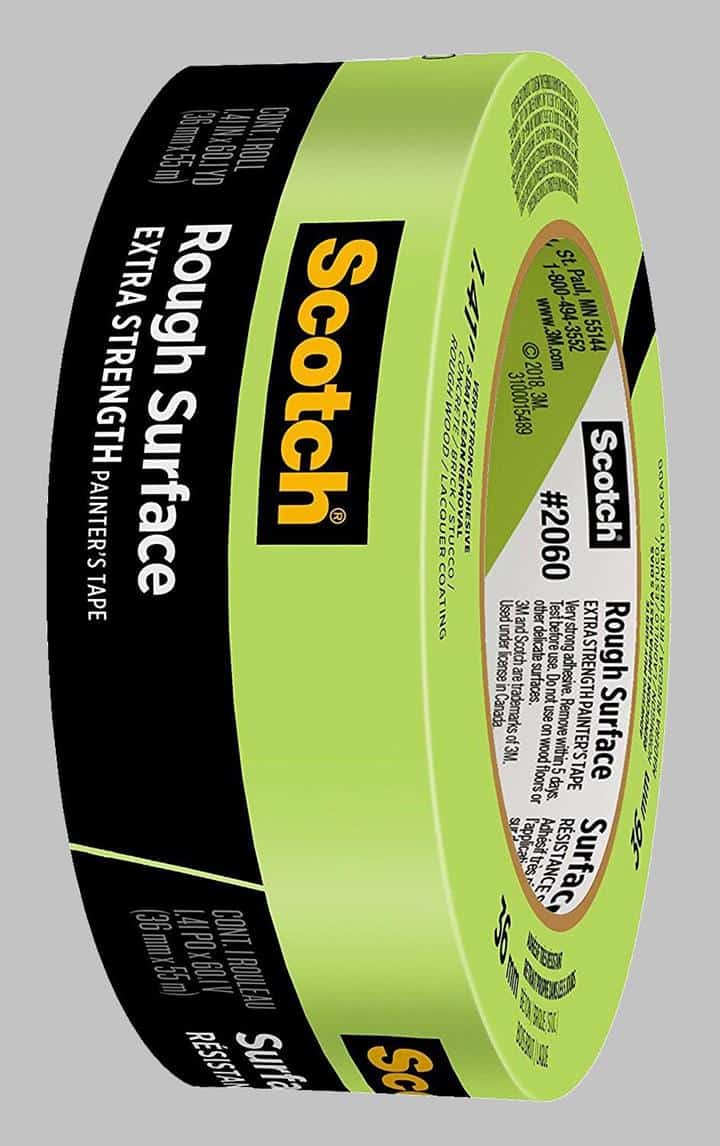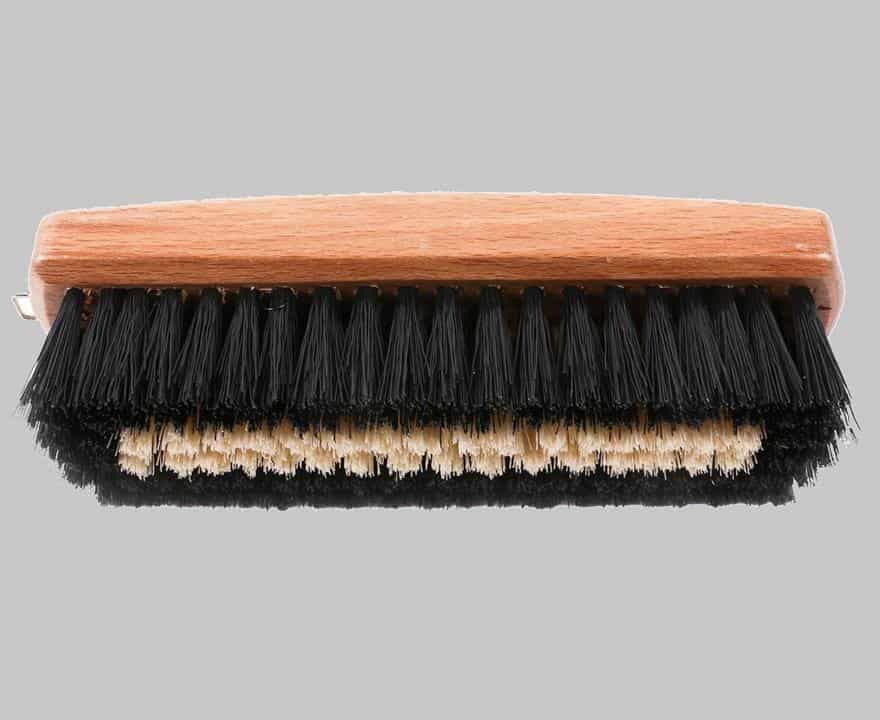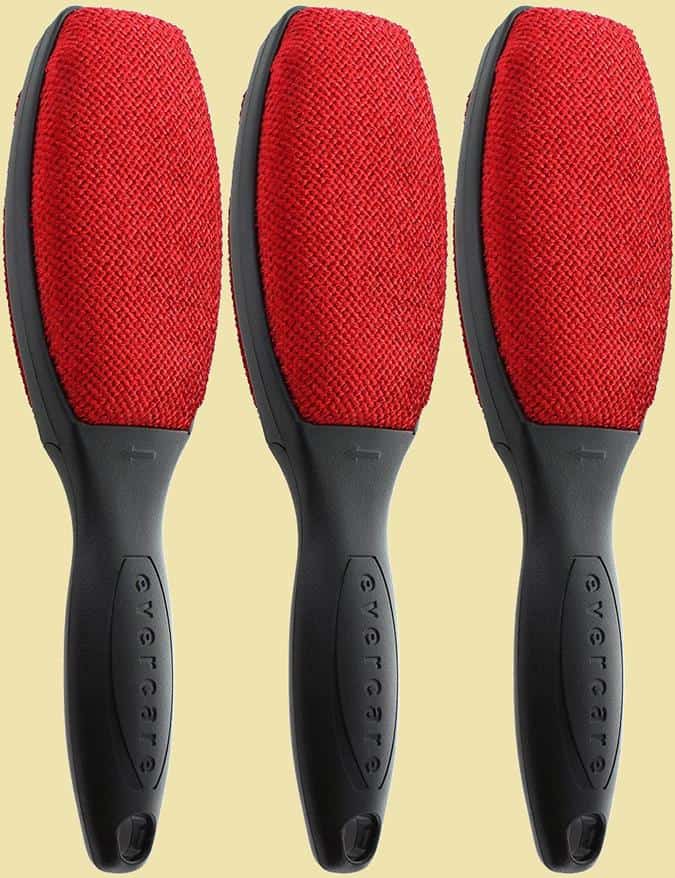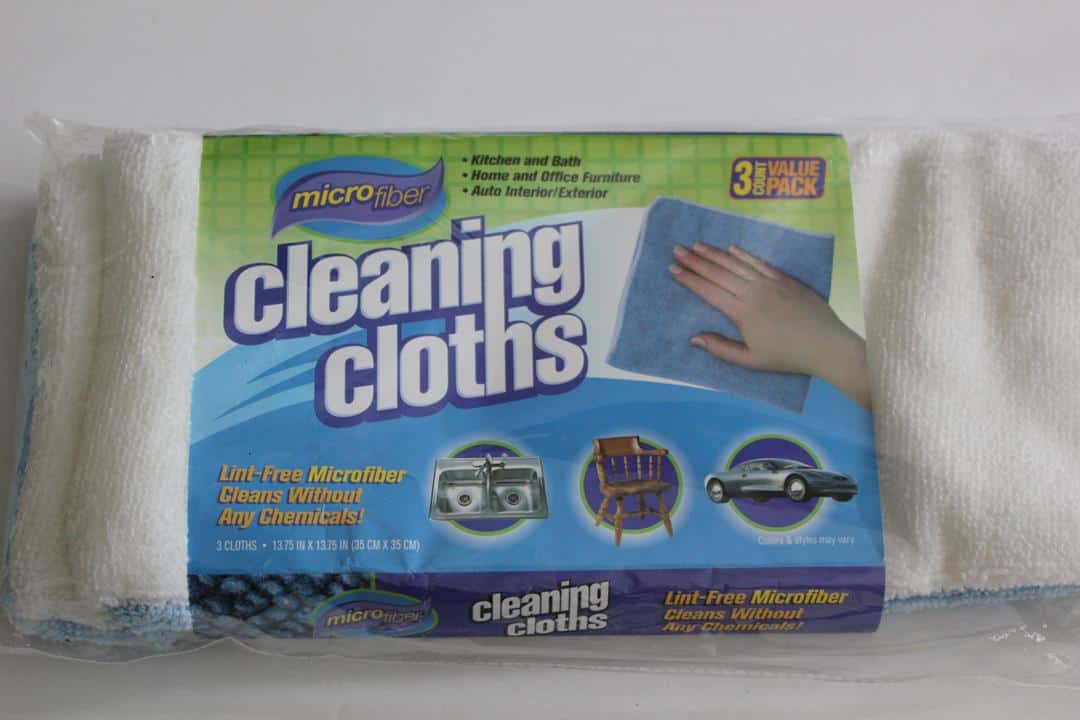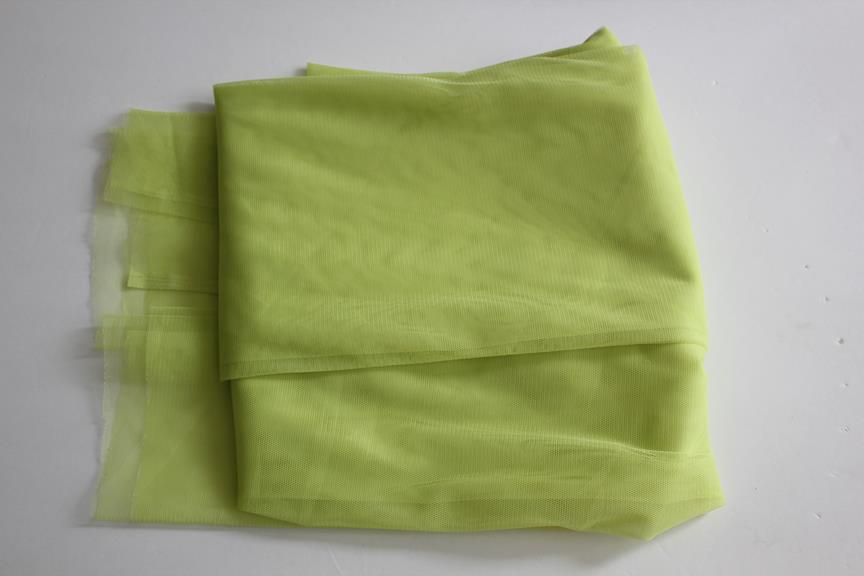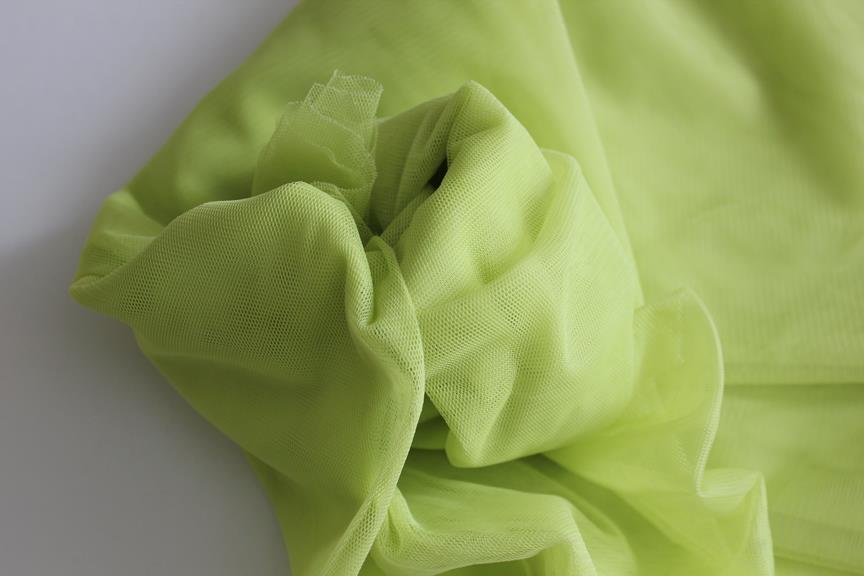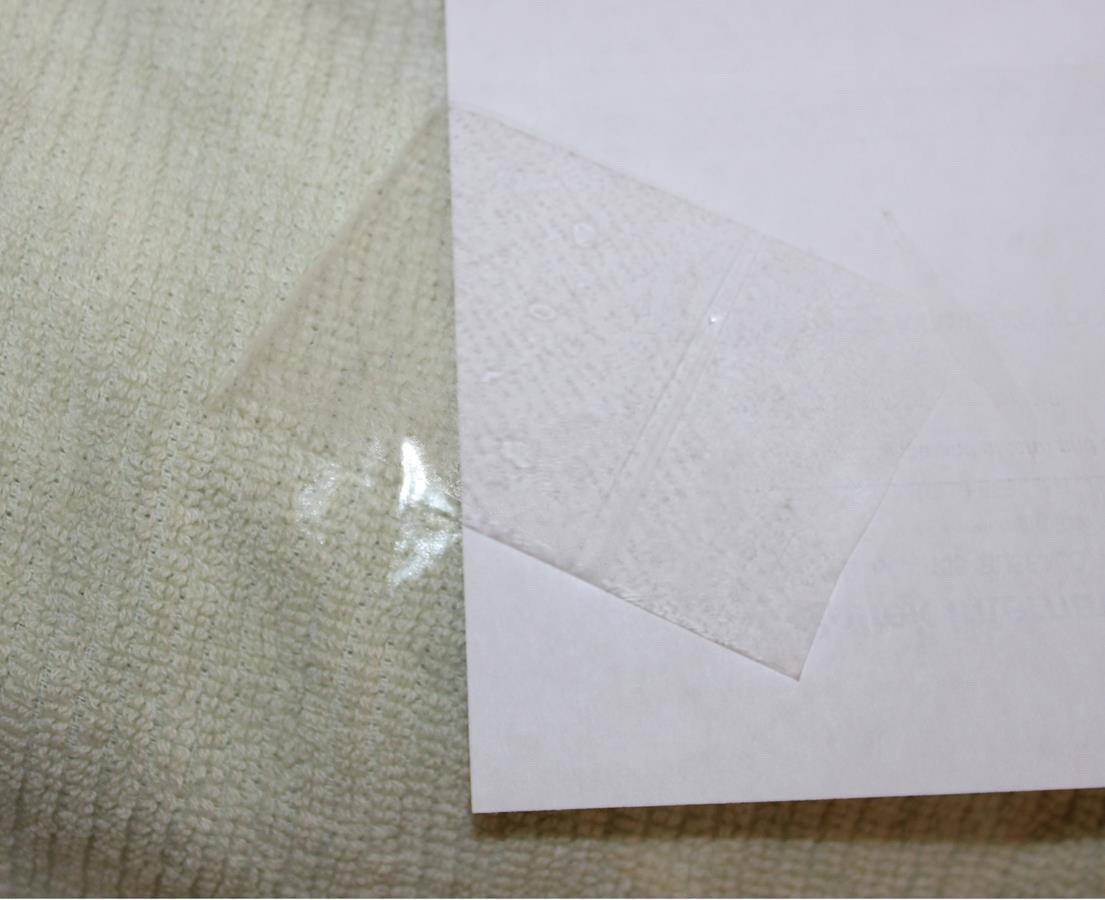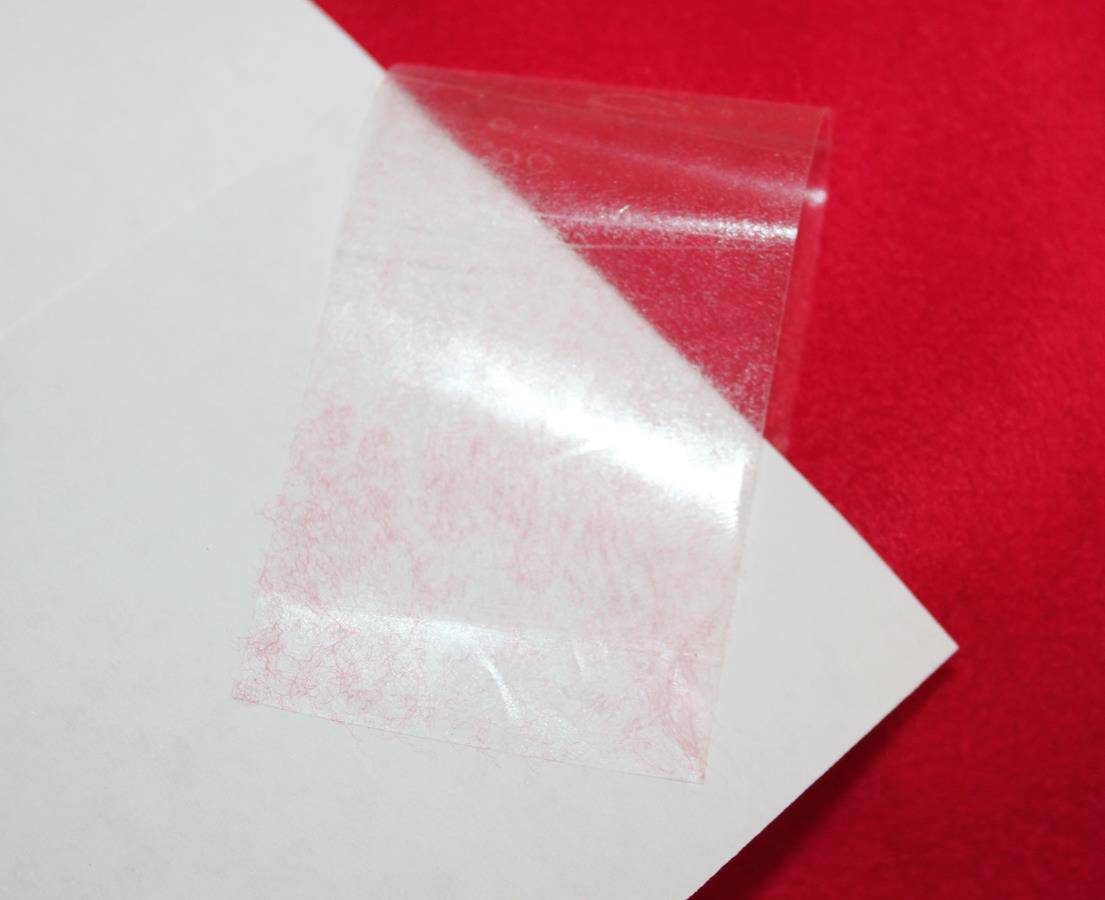How to Get Rid of Lint Balls on Clothes
Let's talk about fabric pilling: what causes pilling (lint balls), how to remove pilling from clothes and how to prevent it.
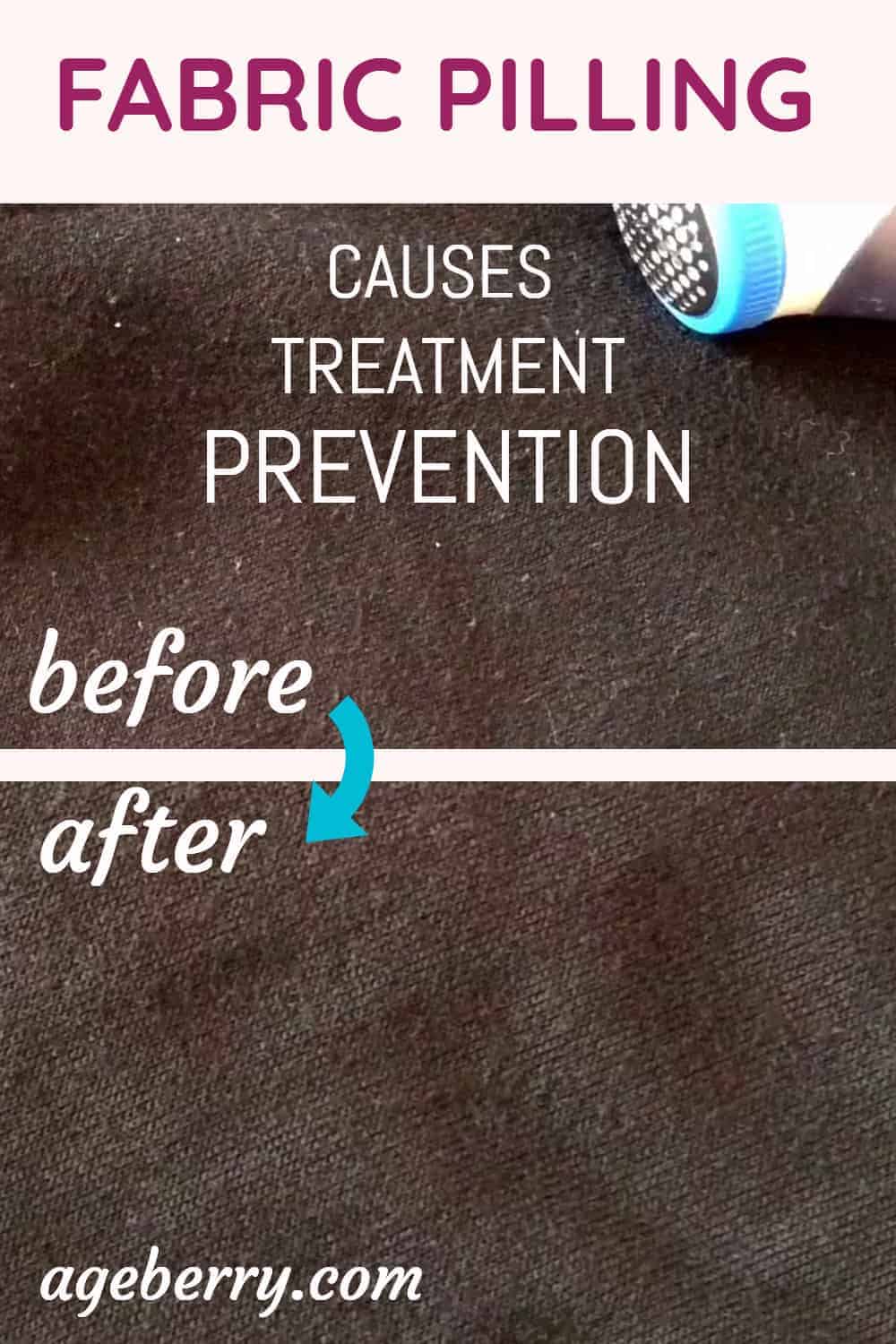
I have to start with a story which, unfortunately, is 100% true. When I first met my mother-in-law, I took extra care to dress as well as I could but it was winter in Canada; can anyone say -20 degrees Celsius? I had to wear a long skirt and a pair of warm tights – my favorite pair of black tights. All was good for one evening, then the next day I was tights-less: coming from the airport after a 10-hour trip I didn't notice when at 11pm at night my mother-in-law started a load of laundry overnight WITH MY TIGHTS IN together with bath towels. Big mistake! When the load was done and dry, as I said I was rendered tights-less: my nice black thick warm tights were now covered with white lint and completely unwearable! What can you do? Well, I went shopping! But now I know many ways to get lint off clothes and prevent fabric pilling.
It's not unusual to have a black pair of pants, coming out of the washer and to your surprise, they don't look as black as they used to! They are full of white fuzzy spots! What is THAT?
I have heard many terms describing this. So I researched; the phenomenon is known under the name of "fabric pilling", or "lint", or simply "fuzz balls" because this is what it looks like. I have also encountered the term "bobbles" and there are probably other terms too. No matter what we call it, it's not pretty and it can render a garment unusable, so we have to deal with it. In this article I will refer to the small fuzz balls as "lint" or "fabric piling".
The most frequent cause of lint is washing. Did you know that washing requires care? If you don't, fibers may become loose and they will surface on the clothes.
This will then give your smooth fabric a rough texture filled with white piles of tiny pieces of fiber: lint. Fabric pilling is caused primarily by friction, and unfortunately, the entire load may be affected. This occurs more frequently when the temperature is too high and the clothes were not grouped properly for washing.
Lint may also occur when friction is being applied by constant rubbing even when outside the washing machine like in the images below. For instance, a sling bag that crosses the chest, or the underarm area. In normal usage, this is usually the sign of a worn garment and since lint forms from the very fibers of the material, it will eventually result in thinner, worn patches.
The conclusion is: when the temperature is too high or too much friction is applied for any reason, the fibers get loose, tangle, break and they pile altogether making that piece of clothing looking less attractive.
But lint that forms from the material's own fibers is not the only type: it can also be formed from another piece of clothing and just clings to our garment.
An example includes a black pair of pants that's been washed with a white cotton towel – you'll see that the lint has a different color than the actual piece of the fabric itself.
While most of the times the lint is unnoticeable, from up close, it can be annoying, not to mention unattractive too. Sometimes, getting rid of these tangled up fibers is impossible as they continue to multiply and cling onto your favorite pieces of clothing.
The good thing is, you don't have to throw away your pile of clothes immediately. There are several methods that you can try to eliminate the lint issue you're experiencing. Let's take a look at them, shall we?
Fabric shaver: corded or cordless, battery operated or rechargeable (also called defuzzer, or lint shaver)
I have a number of these devices and all of them work pretty much the same: they actually shave the lint from the material the same way as one shaves hair. I always wondered if I could actually use a real shaver!
A lot of companies take time to develop this technology and one of the most popular products on Amazon is the Conair Fabric Defuzzer, which is probably not surprising. In the images below are the four devices in active use at this time in my household, all of them are used, they are in different places for convenience.
Note: Some of the links on this page are affiliate links. This means I will receive a commission if you order a product through one of my links. I only recommend products I believe in and use myself.
Do they work? Backed up by verified purchases and reviews and by my own experience, yes.
The majority of people who bought this product have mentioned that the product does exactly what it says, and even more!
They shave off the lint, and as a bonus, help you get rid of pet fur if ever you've run into this kind of problem. I have, and they indeed do help. In fact, there are still shavings in the devices from my own use, visible in the images, these are in actual use in my household.
It's easy to use too, just pass the shaver over the piece of fabric you'd like to remove the lint from and it removes it. It's convenient to keep one in the laundry room to shave the lint after the drier cycle. It's also convenient to keep one near the ironing board because that is when the lint is most visible (you look at the garment after all). It's also convenient to have one near the entrance for a last moment pass over a black sweater, or blazer, before going out.
But we need to be careful when using this device. If you don't press enough it will not shave the lint. But if you press too hard, it may damage the material. I made a short video to demonstrate the use here .
The device comes in various sizes and can be used for different materials; however, it may not be suitable for very delicate fabric.
Keep in mind that removing lint means you literally remove some of the fibers of the material and cutting free the small fuzz balls cuts also the fibers these balls are still attached to, so in time this shaving will actually damage your item.
Unfortunately, there is little one can do once the lint formed, so we will deal later with some methods to prevent it from forming in the first place.
Sweater Stone (or just a regular Pumice stone)
Sweater Stone is a handheld size stone that looks pretty much like a regular pumice stone. Simply pass the stone over the garment. Do this lightly, not too hard as doing so may damage your fabric and it may cause a tear.
Alternatively, if you can't find a pumice stone, you may also use soft-grain sandpaper and lightly rub over the clothing to weed off the lint.
I don't own a proper sweater stone so I used as an example a regular pumice stone that sits in my shower, which I also tested. It works well for small surfaces but I think it is a pain to use for the whole garment. However, on a small surface, the stone worked in my test as you can see in the images below.
It's clearly visible that the area that I rubbed with the stone is relatively lint-free (left side white strip) while the adjacent area has plenty of fuzz (right side white strip).
I did a little more research and I came up across similar products on Amazon such as the sweater stone. One of the best-selling stones on Amazon is the Dritz Sweater Stone which is relatively inexpensive and has good reviews.
I have noticed reading the reviews of this product that people are literally raving about how good this stone is at getting rid of the fuzz, especially after you gain some experience. Apparently it takes a bit of practice to get maximum results. It is supposed to work on sweaters, blankets, upholstery and in my case a piece of stretch soft rayon.
Fabric comb or Sweater Comb
Another product called Fabric comb or Sweater Comb works the same way as the stone.
It works on lightweight sweaters, hats, scarves and wool suits.
Remember, the Fabric comb is for lightweight fabrics, but the Fabric stone for the heavier fabrics.
Using the Sweater Comb is easy too – just lay the clothes flat and gently comb through the fabric going to one direction. Do short and light strokes until you start to see the clothing to de-pill.
This comb comes in two variations, for soft mohair/wool and for all other fabrics, as can be seen in the images below.
Lint Roller
This is probably one of the most famous and well-known tools and in my opinion it's essential. Just move the roller back and forth until the lint is removed from the fabric.
You can also find scented lint rollers but I personally didn't try them. I am basically against all odor-emitting devices. It can't be good for you to inhale another substance which has no business being anywhere near your body.
As soon as the adhesive on the roller is filled with lint, just peel the topmost sheet and discard it. I use this tool mostly to collect pet hair.
In my opinion this device is best for removing lint that comes from other pieces of fabric or other particles like dust, pollen, dandruff, pet hair.
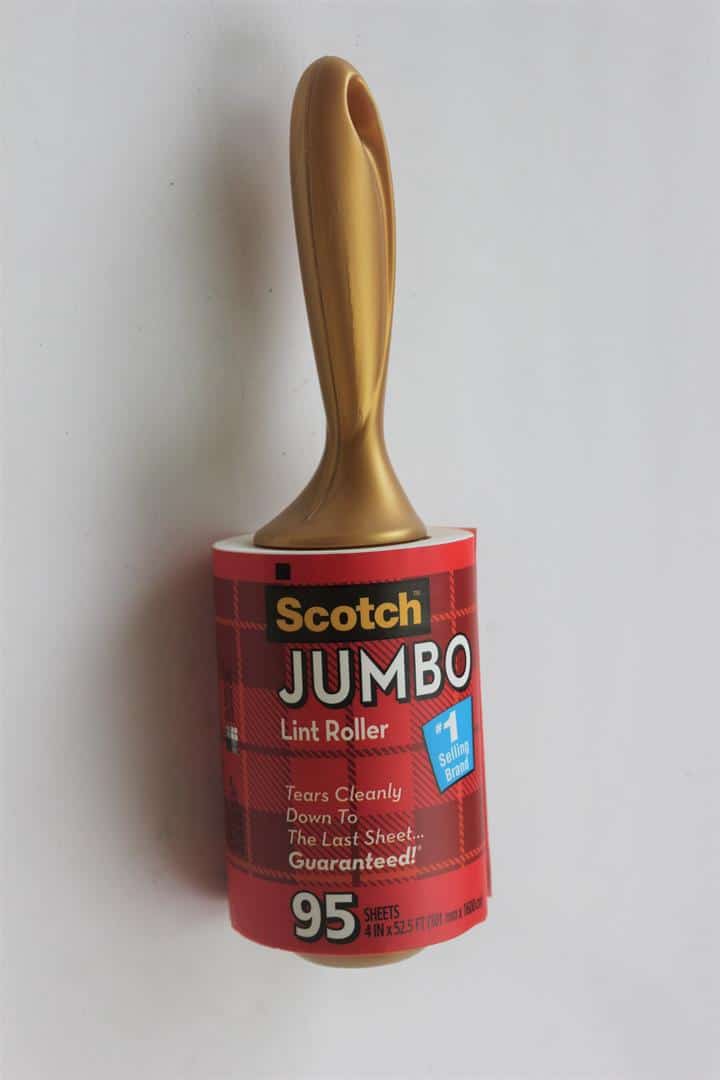
What if you don't own one of these, or for some reasons need to remove some lint asap but can't find one instantly? No worries! You can still get rid of the lint from your clothes. Don't throw them away, and don't pay a dry cleaner to do it for you.
Here are some DIY de-piling methods you can do.
Masking Tape (or even simple clear packaging tape)
A simple and cheap way to make a lint remover when you have no lint remover is to use a section of masking tape.
Any sticky tape works also, the stickier, the better.
Cut a piece of tape and apply it to the portion of the fabric that has lint on it, press gently (make sure it touches the fabric), perhaps rub it a couple of times gently and then lift it. You'll see the lint being lifted and sticking to the tape. The process can be repeated of course.
It works most of the time, especially well on small particles that are external to the fabric, same as the lint roller. Nothing surprising here, after all the lint roller is also just a piece of sticky tape after all.
I will enumerate quickly other common household things that can be employed also in an emergency as lint removal devices.
Single-Edged Razor
Everyone has a razor and a razor has more functions than just shaving off body hair. Hold the razor and gently and carefully run it over the clothing. It shaves the lint but you need to make sure that you're extra careful with this method since it can easily damage the fabric, especially if the razor is new. You don't want to end up cutting the fabric!
Scissors
Alternatively, you can also use some mini scissors to cut the lint pieces, especially large fuzz balls.
Again, be very cautious when doing this as we don't want to cut the garment itself. Make sure that your scissors are sharp enough.
Again, this might be a time-consuming process, but when done properly and carefully, this method won't damage the surrounding fabric. I have myself used this method to remove stubborn lint from a very limited area of a garment, usually what the other methods could not get rid of lint easily.
Glad Press 'n Seal
Yes, this works too, and not bad either for dust, pollen, pet hair. Not the usual plastic wrap, this is the one that is sticky on one side. If you have one of these lying at home, you can also try to use it as a lint remover.
Mr. Clean Magic Eraser
Here is a sentence from one review I read on Amazon about this: "Magic eraser isn't called magic eraser for no reason! For a super soft sweater, Magic Eraser works wonders. Make sure that you get the sponge that has the "extra power" variant in it. Let's take a moment to thank Mr. Clean, shall we?" I knew this works on kitchen dirt, I used it for scrubbing tile floors, walls, sinks, but lint? Apparently, yes!
Comb with fine teeth
If you're looking to get rid of the pilling from heavy knit sweaters and other materials, it's worth trying this out.
Lay the garment on a flat surface and run the comb in one direction. As you go, you'll notice that the pills will accumulate on the comb. This works basically the same like the Sweater Comb, which we have discussed earlier. So it's safe to say that this is a perfect alternative to sweater comb.
Vacuum cleaner
You'll be probably not surprised that I mention this, I am sure all of us have attempted to use the vacuum at some point for removing lint, dust, pet hair.
Just attach the brush used for furniture and go over the garment lightly. Go back and forth – gently!
As compared to the tools that can be easily bought from Amazon, this may be a tedious and slow process, but it definitely works!
Lint brush
What I have obviously omitted here? My grandmother didn't have a vacuum, she didn't know sweater combs existed, sticky tape was probably still 50 years in the future, but lint, dandruff, hair, dust is as old as humans. What did she use?
I can tell you: something that she had inherited from my great-grandmother: the lint brush! This was always present on the shelf right at the entrance and was used always to brush jacket shoulders and pants. And indeed, a stiff lint brush works very well even if we no longer like to use low-tech gadgets.
Just for fun, I tried to see if there is any battery operated / electronic / electric lint brush; I could not find any. I feel ancient, having known and used such a device!
But I DID find a modern equivalent which I also use and I can attest it also works.
How to prevent fabric pilling
We've talked about different methods of how to get lint off clothes using special tools or common household items.
The other half, perhaps the more important one, involves preventing fabric pilling from building up. Why more important? Remember that the lint, or fuzz balls, are in fact formed from the material's own fibers and removing them also removes one tiny bit of the material. There is only so much lint we can cut until there is no fabric left!
How does it go: one ounce of prevention equals one pound of cure? So, let's talk prevention: here are some proven methods to avoid the occurrence of lint altogether or, at least, to minimize its occurrence. Don't expect any of these methods to work 100%, but the methods presented below will really lower the effect.
Usage of the washer/drier
Lint problems will be exacerbated by long wash cycles, long dry cycles, high temperatures, static electricity created during dry cycle. Minimizing the time in the washer/drier, using a delicate cycle, using a fabric softener during drying cycle – all these will minimize the amount of lint formed.
Handwash items if possible.
Air dry if possible, not only will you minimize lint, you will also save money. Note: not everything is suitable for drying on a line, outside. This tends to leave some garments stiff and wrinkled. You will need to find a balance probably and if you plan to air dry, then you may want to consider adding the fabric softener to your wash cycle since you can't use the drier softener sheets.
Use a liquid detergent as this is softer on the clothes. The powder detergents frequently feature small abrasive granules which will increase friction. If you will be using a laundry powder and if your machine allows this, consider dissolving the powder in water before adding your clothes.
Lay knitted fabric flat to dry, especially the fabric that is soft and where the fibers are looser. This will keep them from the strain of hanging on a line and being pulled downward by gravity. Laying them flat will help keep their structural integrity. It will also avoid stretching the fabric, and some materials – like wool – MUST be air dried or else you will have a shrinkage problem. Do you really want to make a handkerchief from a sweater?
Microfiber Squares / Pieces
Add this into your dryer – they are extremely good at collecting fuzz. I don't have an explanation, probably because microfiber is extremely good at creating static electricity and it attracts lint? But it works. They don't have to be squares, they can be any shape, perhaps whatever remains from a sewing project? Or you can buy from almost anywhere.
Use a netting lint catcher
If you don't have a commercially produced lint catcher, you can make your very own out of a square of netting or voile (the type of fabric used for a wedding veil) like in the images below.
Throw this in with the wash or in the drier and it can attract all lint, the same like the microfiber squares do.
Next time you are at a fabric store you can also pick up some material, the color is irrelevant, you can use whatever is on sale. Just a yard is all you will need.
Roll the netting into a tight ball and throw it in the washer or the dryer. The smaller the holes in the net the better their lint-capturing capacity. Yes, it can be used for both washing and drying cycles and it costs next to nothing.
Vinegar
Adding a cup of vinegar to your load (with the detergent) helps prevent fuzz. Yes, I tested this and it really works.
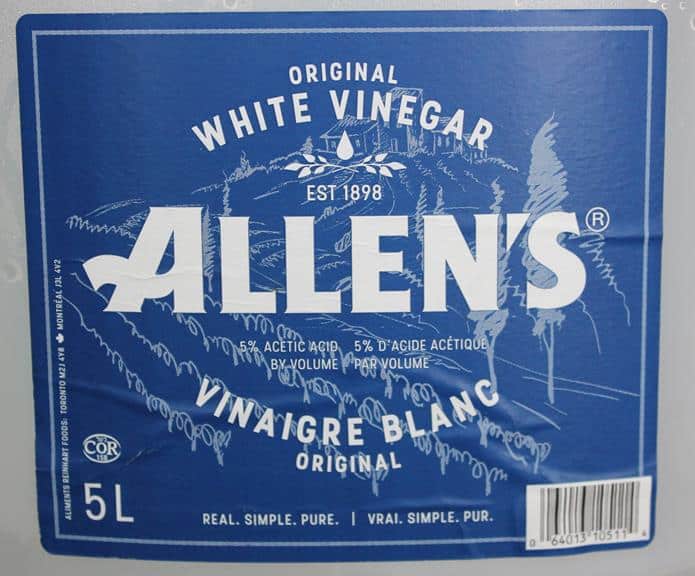
Anti-Static Spray
We've talked about lint occurring because of the friction and static electricity, right?
Using this spray minimizes the creation of static electricity mainly by minimizing friction and of course this also helps repel the lint. Just spray on the surface of your clothes.
I feel I need to mention this but I myself am not a fan of using this very often because it introduces new substances to the fabric, substances that might be harmful.
But you might not really have a choice for reasons that have nothing to do with lint. Fabric that is made up of synthetic fibers is very good at creating static electricity – unless you use an anti-static spray. And you might not like your skirt to cling to your legs, right? So sometimes you have to use this, and the fact that it protects against lint is an added benefit.
Turn clothes inside out for laundry
Another trick that you'd want to try is turning the clothes inside out. Once you're done, put them in the wash. When friction occurs, lint may be created but the right side of the fabric will be somewhat protected. Yes, lint will be created as usual on the wrong side, but since it will be mostly hidden, its effect will be minimized.
Check pockets before laundry
Check pockets for cash or tissues or simply accumulation of dust or lint in the bottom of the pockets. During washing this may be set loose – the paper will shred for sure – and will cling where you don't want it. I know, this is based on personal experience.
A funny note: what is the piece of paper we most frequently have in our pockets? Yes, it's money. How many times did you find pieces of banknotes in the laundry? I know I did! Talk about expensive lint!
Segregate Your Laundry
Washing your clothes in one load is definitely easier, but it's more prone to creating lint. To minimize the problem, segregate your clothing not only by color, but by fiber type also and wash them separately.
For instance, wash cotton clothes separately from non-cotton garments. Do not mix light clothes with dark, not only to avoid color problems, but also because lint of light color on dark clothes is much more visible. Wash separately those garments that have fluffy materials and are prone to shedding fibers, like fleece and terry cloth towels, for example.
You may also want to separate towels from your garments as they tend to shed more fabric, which may cause the fuzz to stick to some of your clothes.
Handwash
I have already mentioned handwashing. Yes, for delicate garments especially, it's ideal to handwash rather than use a washing machine. Sure, it takes more time and effort, but there's less friction when you wash by hand, which means that it's less likely that the material will create or collect fuzz. Probably not everyone has the time to do this, but you should still consider it for those fabrics that are delicate and a bit more expensive.
By the way, I found a funny alternative to handwashing (and it works really well!). If you want to know what it is – check out my artice "How to wash silk".
Netting (mesh) bag
Place those clothing items that are more delicate in protective mesh bags. This will stop them from rubbing up against one another and compromising the structures of their fibers.
Mesh bags are so useful! I like to use them and I have even written an article about DIY mesh bag using recycled materials. But if you don't have the time to make them yourself, they are relatively cheap and come in a variety of sizes.
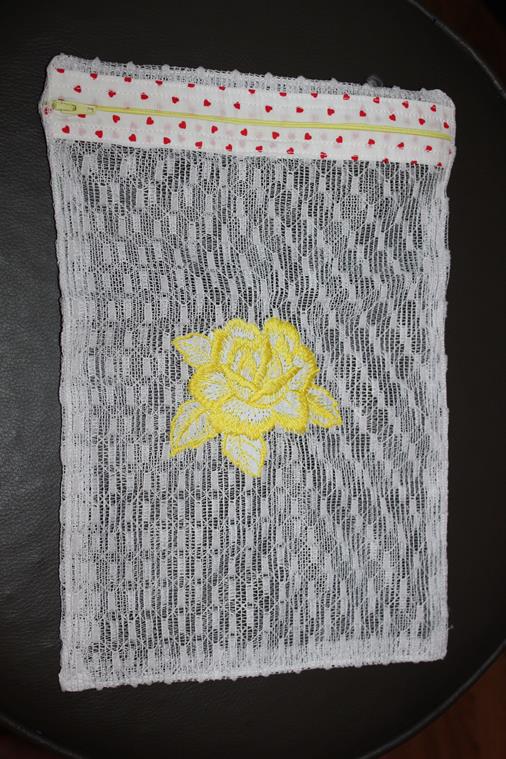
Which Types of Garments Are Most Likely to Cause Lint
- Knitted sweaters and t-shirts are most likely to produce lint
- Knits are much more likely to produce lint then woven fabric
- Rayon is a very linty fiber
- Cotton undergarments are also culprits
- Blankets, towels, flannels, woolen clothes, velour, and corduroy are not far behind
- Fleece and terry cloth are major lint producers, wash separately if possible
I have to mention though that lately I see a new type of fleece with "anti-pill" properties. Each merchant might call it differently, here is a link to fabric.com inventory of lint resistant fleece.
Avoid clothes that produce lint or attract lint
Understanding which clothes produce most lint makes it easier for you to separate them with your laundry, so you can wash them properly, and protect your other clothes from getting fuzz as well.
Of course, you will not be an expert instantly, and the material, as it ages, will change its lint creation capabilities. The older the material is, the more lint will be produced because the fibers will become looser.
If you notice in a store that a particular item already has some lint on it, you can bet it will pick up a lot more if you wear it, and even more after a while and during wash. Skip this item and the problem has been nipped in the bud.
What if you really, really like the item, the price is right and you hate to shop further (yeah, right!)? Well, this is why I left this for the end, while lint (and other factors, like wrinkling) should be taken into consideration, certainly they are only a small part of the decision.
Will Dry Cleaning Remove Lint Balls?
Perhaps it will but I would not hold my breath. Dry cleaning is not the best way to remove lint from your clothing. It may be a good way to keep odors and specific stains from your clothes, but for lint, dry cleaning is not a good option.
What are some other ways to keep your clothing free from lint?
The quality of the fabric is very important from this perspective. The type of the fabric and the type of the fibers also play a crucial factor. Here are some considerations that can give you an idea of the lint producing capacity of different fabrics.
Adhesive tape test
Before you purchase a fabric perform a simple adhesive tape test to determine how loose the fibers are in the fabric and how easily is to separate them.
Take a small piece of adhesive tape, nothing too powerful, and press it on to the fabric in question. Peal it off slowly and examine what you find. If there are many small pieces of fuzz and lint, this means the fibers are already loose and it's likely this fabric will be producing lint.
However, if your tape is clean then the fibers show to be not loose and the materials will be less likely to produce lint. Of course, as the material ages and is worn, lint will be created sooner or later.
In the images below I am showing how the tape looks like after such a test. It's clear that the red fleece material is linty while the green material is not. The pieces of fibers can easily be seen in one case but in the second case, while the texture of the green material is imprinted on the tape, there are no fibers.
Buy quality fabric
Buying quality clothes or fabric (for DIY items) is always the way to go and not only for lint – the good quality material will maintain its shape, color and integrity much longer and you will be more likely to wear it again and again.
I have not invented the say "I am too poor to afford cheap things" – it's true. Always, always buy the best quality you can afford. You will save money long term and as an added bonus you will have nicer things and probably be more comfortable.
Avoid Fiber Blends
Those materials made of multiple types of fibers have a greater tendency towards producing lint. This is especially true for those that combine natural fibers with synthetics.
This is a good reason to always check those fabric labels – it can save you from unwanted experiences later.
Finally, avoid anything that includes three or more fabric types, these are the worst. If you think about it, it does make sense – the different types of fibers will have different properties and will probably be more likely to separate – therefore show wear – then the fabric made with only one type of fibers.
Choose Tightly Woven Fabrics
Have you ever noticed that those pieces of clothing that have the most lint are knits and looser woven fabrics?
That's because tighter woven fabrics maintain a better hold on their individual fibers and are therefore less likely to begin coming apart. Even though tightly woven options are better in the long run, if you must have a knitted fabric, look for those that are tightly knitted.
Choose natural fibers if possible
It's proven that natural fibers are less prone to lint creation than synthetics; for many reasons. But choosing natural fibers is not only for lint protection, you protect yourself too. I am a big believer in using organic and natural materials wherever possible and I didn't make a secret out of it. I have a number of articles on this subject: "Chemicals We Wear Everywhere", "Certified Organic Cotton Benefits" and "Organic Cotton Fabric Review".
Protect your clothes
Do you drive a lot? Do you wear a seat belt? If you do, I am sure you have noticed the wear and beginning of lint creation under the seat belt. Using a seat belt may save your life, and I see no reason why not save your clothes from the seat belt wear with a padded covering. The padded covering may have the added benefit that you can wear the seat belt even if it comes in contact with naked skin (for example if you wear a halter top or tank top).
Did you find this tutorial helpful? If so, save this pin (see below) on your sewing board so you can come to this tutorial later when you need it and follow me on Pinterest for more tips, tutorials, and inspiration!
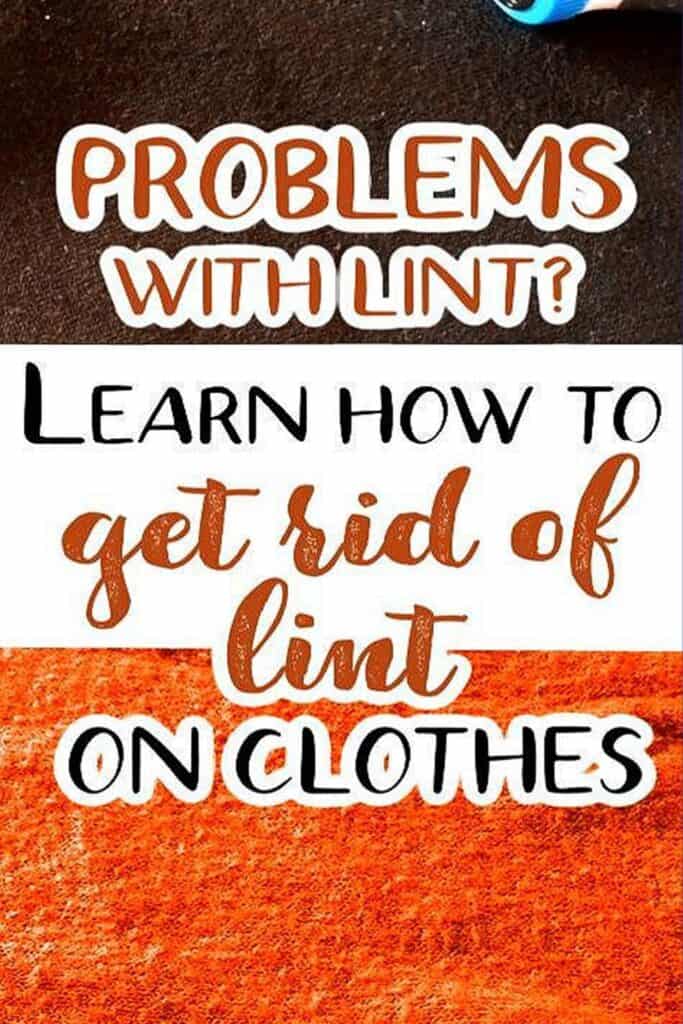
How to Get Rid of Lint Balls on Clothes
Source: https://www.ageberry.com/prevent-fabric-pilling-get-lint-off-clothes/
